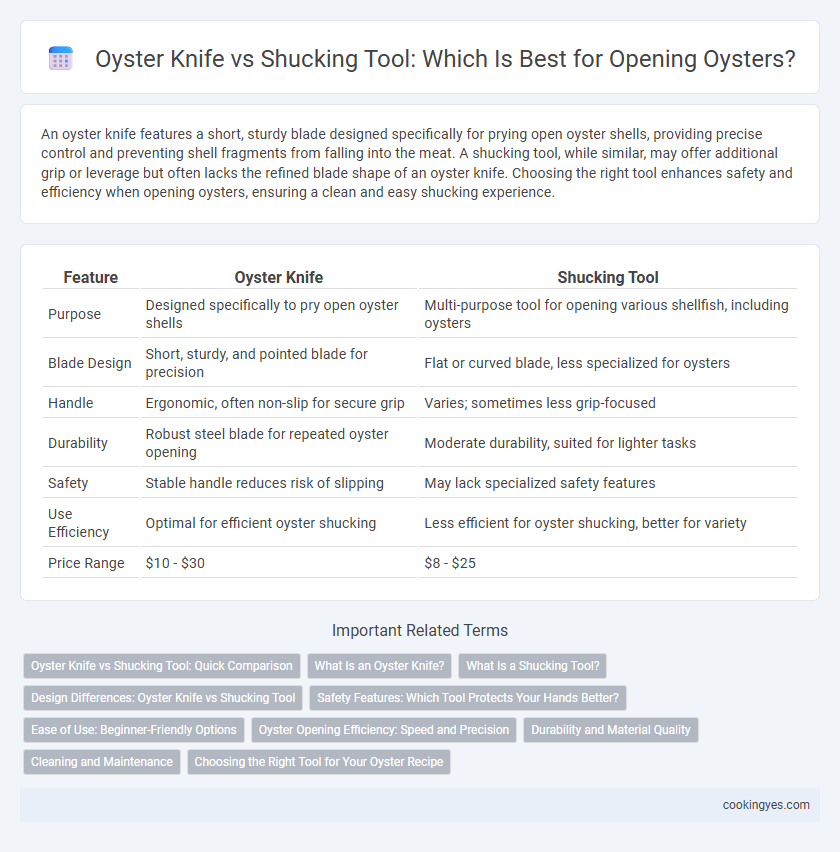An oyster knife features a short, sturdy blade designed specifically for prying open oyster shells, providing precise control and preventing shell fragments from falling into the meat. A shucking tool, while similar, may offer additional grip or leverage but often lacks the refined blade shape of an oyster knife. Choosing the right tool enhances safety and efficiency when opening oysters, ensuring a clean and easy shucking experience.
Table of Comparison
| Feature | Oyster Knife | Shucking Tool |
|---|---|---|
| Purpose | Designed specifically to pry open oyster shells | Multi-purpose tool for opening various shellfish, including oysters |
| Blade Design | Short, sturdy, and pointed blade for precision | Flat or curved blade, less specialized for oysters |
| Handle | Ergonomic, often non-slip for secure grip | Varies; sometimes less grip-focused |
| Durability | Robust steel blade for repeated oyster opening | Moderate durability, suited for lighter tasks |
| Safety | Stable handle reduces risk of slipping | May lack specialized safety features |
| Use Efficiency | Optimal for efficient oyster shucking | Less efficient for oyster shucking, better for variety |
| Price Range | $10 - $30 | $8 - $25 |
Oyster Knife vs Shucking Tool: Quick Comparison
Oyster knives typically feature a short, sturdy blade designed for prying open oyster shells with precision and control, while shucking tools often include additional safety features like blade guards and ergonomic grips to reduce hand fatigue. Compared to shucking tools, oyster knives offer better maneuverability and are preferred for delicate shell work, but shucking tools provide enhanced protection against accidental slips. Choosing between an oyster knife and a shucking tool depends on user experience and safety priorities during oyster opening.
What Is an Oyster Knife?
An oyster knife is a specialized tool designed with a short, sturdy blade and a pointed tip to safely pry open oyster shells without damaging the meat inside. Unlike general shucking tools, oyster knives typically have a thick, non-slip handle for a secure grip and precise control during the opening process. This design ensures efficiency and safety when separating oyster shells in culinary or seafood preparation settings.
What Is a Shucking Tool?
A shucking tool is specifically designed for opening oysters by leveraging a sturdy, short blade that fits into the shell hinge, allowing for safe and efficient prying. Unlike standard oyster knives, shucking tools often feature ergonomic handles and reinforced tips to reduce the risk of injury during the opening process. These tools are essential for professional shuckers and seafood enthusiasts seeking precision and durability.
Design Differences: Oyster Knife vs Shucking Tool
Oyster knives feature a short, sturdy blade with a pointed tip designed to pierce the oyster shell and pry it open with precision. Shucking tools often have a broader, more rounded blade to provide greater leverage and reduce hand fatigue during prolonged use. The ergonomic handle design of oyster knives emphasizes control, while shucking tools prioritize comfort and safety for repetitive shucking tasks.
Safety Features: Which Tool Protects Your Hands Better?
Oyster knives feature short, stout blades with blunt, rounded tips designed to prevent slipping and puncture injuries, enhancing hand protection during shucking. Specialized shucking tools often include ergonomic handles and hand guards that shield fingers from accidental slips, providing an added layer of safety. Prioritizing tools with non-slip grips and robust blade construction significantly reduces the risk of hand injuries when opening oysters.
Ease of Use: Beginner-Friendly Options
Oyster knives typically feature a sturdy, short blade designed for easy insertion and leverage, making them ideal for beginners seeking a secure grip and controlled pressure while opening oysters. Shucking tools often prioritize ergonomic handles and safety features like finger guards, enhancing ease of use and reducing the risk of injury during shell prying. For novices, choosing an oyster knife with a blunt tip and non-slip handle offers greater confidence and efficiency in cracking open oysters without damage.
Oyster Opening Efficiency: Speed and Precision
An oyster knife is designed with a sturdy, short blade ideal for precise insertion into oyster hinges, offering enhanced control and reducing the risk of shell fragments. In contrast, shucking tools often feature specialized grips or leverage mechanisms that increase speed but may sacrifice fine precision. For optimal oyster opening efficiency, balancing swift hinge penetration with careful shell handling is crucial, making the oyster knife the preferred choice for accuracy, while shucking tools may suit high-volume settings.
Durability and Material Quality
Oyster knives typically feature high-quality stainless steel blades and ergonomic, durable handles designed to withstand the pressure of prying open oyster shells without bending or breaking. Shucking tools often combine robust metal blades with reinforced grips, but variations in material quality affect their longevity and resistance to corrosion, especially in saltwater environments. Choosing an oyster knife with a thick, rust-resistant blade and a strong, non-slip handle ensures greater durability and safer, more efficient oyster shucking.
Cleaning and Maintenance
Oyster knives typically feature stainless steel blades that resist rust and corrosion, making them easier to clean and maintain after use. Shucking tools often have ergonomic handles but may include complex parts that require thorough drying to prevent mold and deterioration. Proper cleaning with warm water and mild detergent, followed by immediate drying, is essential to preserve the longevity and hygiene of both oyster knives and shucking tools.
Choosing the Right Tool for Your Oyster Recipe
Selecting the right oyster knife is essential for safely and efficiently opening oysters, as its short, sturdy blade provides precise control and minimizes shell damage. In contrast, a shucking tool, often used by professionals, offers enhanced leverage and grip for larger or tougher oysters, making it ideal for recipes requiring intact oyster presentation. Consider the oyster size and recipe technique to determine whether the compact oyster knife or the robust shucking tool best suits your culinary needs.
Oyster Knife vs Shucking Tool for opening oysters Infographic

 cookingyes.com
cookingyes.com